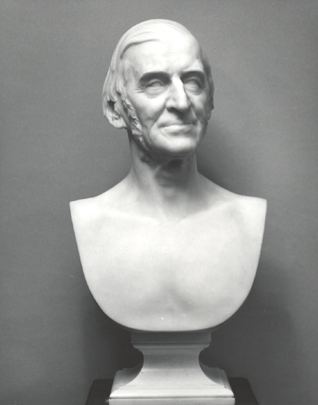 |
FRENCH’S BUST OF
EMERSON
81. Daniel Chester French. Ralph Waldo Emerson,
carved 1883/84, from original clay model 1879. Marble bust.
“ … gift from one hundred and thirty-five contributors, including Mr. French
himself, who was the largest contributor … ”—Report of the Trustees
of the Free Public Library, 1883/84.
Concord sculptor Daniel Chester French (1850-1931) was born in 1850 in Exeter, New Hampshire. His father was Henry Flagg French, a lawyer, judge, and, later, Assistant Secretary of the United States Treasury. The Frenches moved to Cambridge when Dan was six, then to Concord in the 1860s, to a house on Sudbury Road (now 342). French’s artistic talent was first noticed by his stepmother, who was impressed by the little figures he carved out of turnips and pieces of wood. Artist May Alcott (Louisa May’s youngest sister) took an active interest in helping him develop his skills. She gave him her modeling clay and tools, and advice on how to use them. French learned quickly. He studied with William Morris Hunt and William Rimmer in Boston and worked in the New York studio of John Quincy Adams Ward. His earliest subjects were his family and friends, who sat for portrait busts. Concord’s award to French of the commission for the Minute Man statue established him as a public artist. When the Minute Man was unveiled at the 1875 centennial celebration of the Concord Fight, French was in Florence. On his return in 1876, he set up a studio in Washington, resettled in Concord in 1878, and in 1879 built a studio next to his family’s home on Sudbury Road. This bust of Emerson was created early in French’s career. Because Emerson was a French family friend and had encouraged Dan in his work, there was a warm personal connection between the sculptor and his subject. French began work on the bust in March of 1879. He went daily to Bush, where Emerson sat for him, and had the piece done by the end of April. The bust was first modeled in clay. Plaster casts were made from the clay model and, later, two marble carvings. One of the first plaster casts from the master mold was presented to Emerson on July 26, 1879. Emerson is reported to have commented on seeing it, “Dan, that’s the face I shave.” Within a few years, French had a marble version of the bust carved in Italy. This first marble carving was given to Harvard in 1883 by the Higginson family. In 1884, a second marble carving, slightly different from the first, was presented to the Concord Free Public Library by one hundred and thirty-five contributors, including French himself. By 1886, bronze copies of the Emerson bust were available for sale. The piece was one of French’s dependable money-makers. Later, French described how difficult it had been to see beyond the failings of the elderly Emerson—he was seventy-six when he sat for the piece—and to capture the personality and the intellect of the man. He referred to Emerson’s “almost child-like mobility that admitted of an infinite variety of expression, and made possible that wonderful ‘lighting-up’ of the face, so often spoken of by those who knew him. It was the attempt to catch that glorifying expression that made me despair of my bust. At the time I made it … Mr. Emerson had failed somewhat, and it was only now and then that I could see, even for an instant, the expression that I sought.”
No image in this online display may be reproduced in any form, including electronic, without permission from the Curator of Special Collections of the Concord Free Public Library.
Next Entry - Previous Entry - Back to Section VIII Contents Listing - Back to Exhibition Introduction - Back to Exhibition Table of Contents |